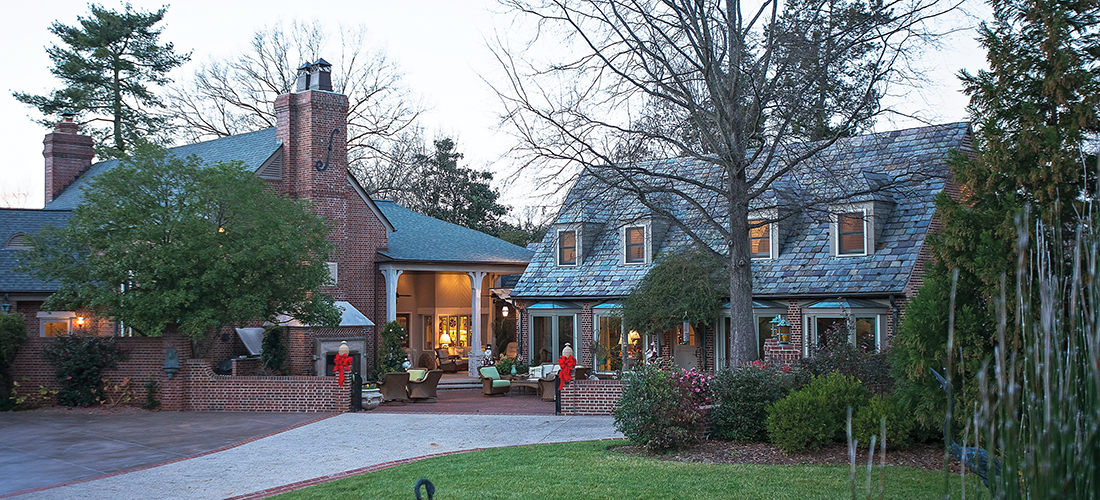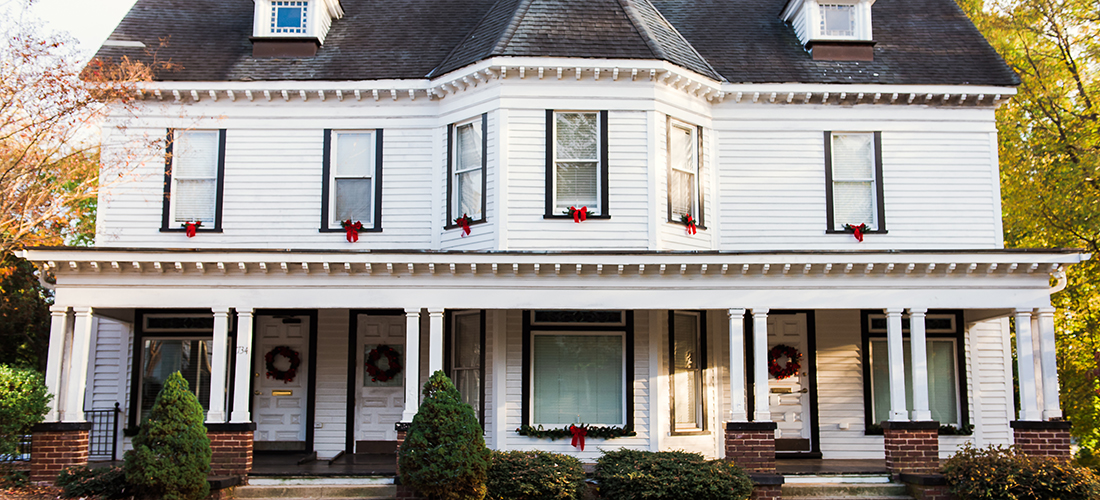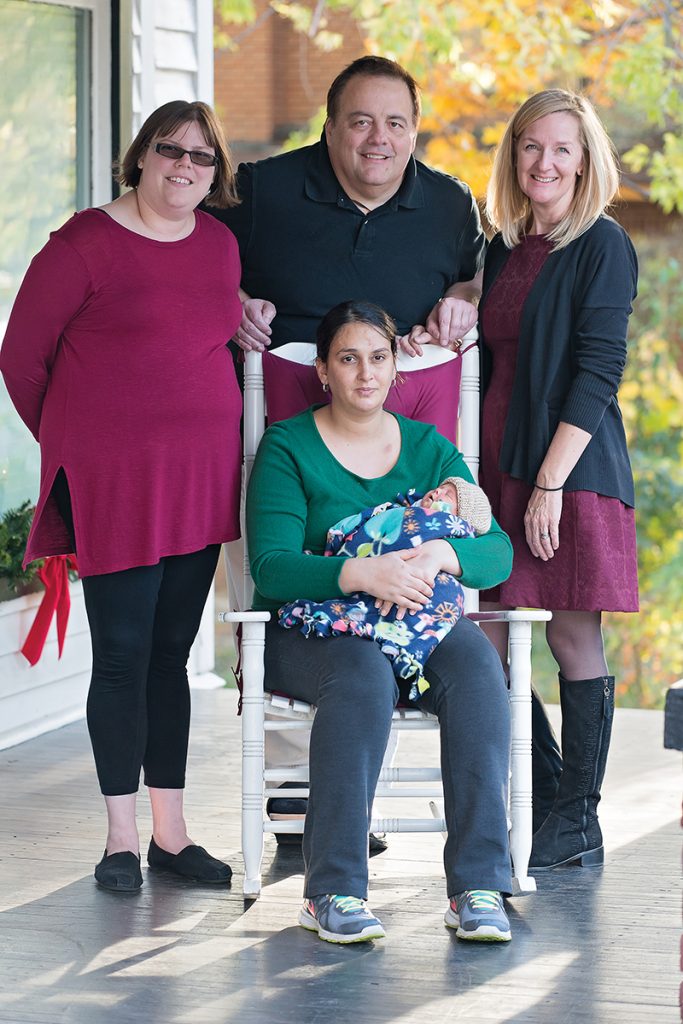Out of the Shadow of Shadowlawn
For the Culler family, home is truly where the heart is
By Cynthia Adams • Photographs by Amy Freeman

“The story of our house — destroyed,” is the heading written neatly on a sheet of legal paper. Below the heading are notes, penned by Ashley Culler. She has a Christmas story unlike most, and one she has finally decided to tell.
Hers is the story of what was lost, but more importantly, what was found.
Ashley and her husband Braxton’s current Emerywood house in High Point is a beauty. Although the newer section of their home is only a few decades old, skillful renovations make it appear as if it were much older. The carriage house, however, is a period piece that once belonged to the “lost house” and is now a wing of the Cullers’ new home. Some of the artful trickery employed to give this new home vintage appeal results from craftsmanship better known to another century. Authentic plaster-cast moldings and 1920s era details appear throughout the main rooms and even show up in private areas, such as dressing rooms.
The home features a few relics, lovingly restored, carefully salvaged from the family’s prior house that once stood only a few yards away.
The most obvious artifact of the lost house is what they now call a gazebo. It stands as a proud and touching emblem. It was a covered stone and brick rear entry, formerly attached to their destroyed home but now freestanding.
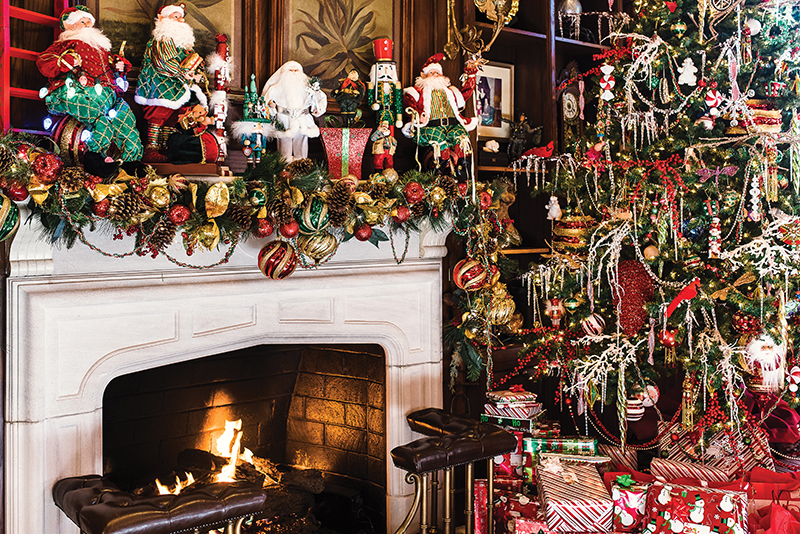
There is a chandelier in the elegant red dining room and wall sconces that were sent to New York for restoration. A few leaded glass windows (salvaged, miraculously enough) were installed near the library. A once-charred mantel was plucked from the ashes and placed in the living room — and a single finial in the front stairwell is nearby. A few beams, recovered from the former dwelling, made their way to an outdoors terrace. These emblems are not only architecturally important; they are symbolic of this family’s triumphant rise from a tragic fire during Christmas six years ago.
What the Cullers’ new home doesn’t have are any pieces of furniture, any paintings, any crockery, memorabilia or pictures, not even a single family photo, from their former one.
That is all gone, lost in the fire and belonging to the past. What the Cullers do have are a glorious present and a sense of gratitude.
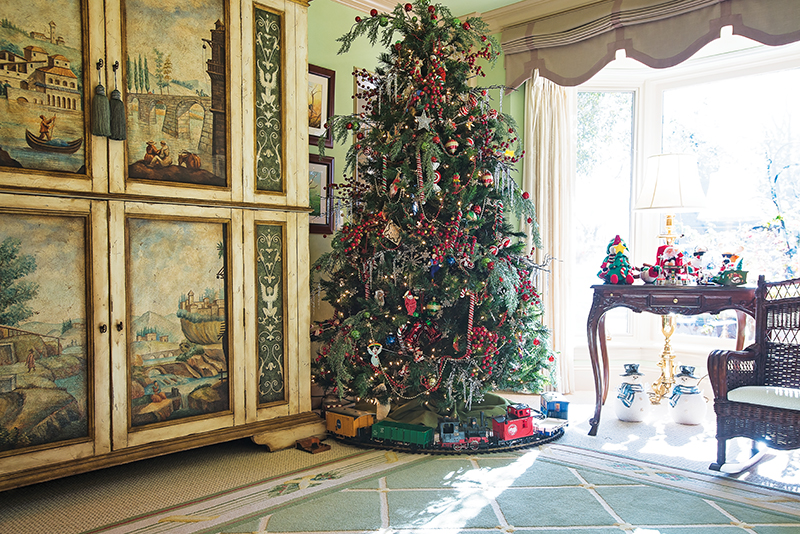
Come Christmas, the “new” Culler house glows within and without, with twinkling beauty. High Point designer John Paulin, of Grassy Knoll, drapes the exterior and the surrounding evergreens on the sizeable property with fairy lights. Iron reindeer that were spared immolation are on display on the lawn. Inside, traditional Christmas colors are employed and a family Nativity scene is on display that once belonged to Ashley Culler’s mother. After her mother’s death, the tableau was carefully restored by artist Dana Holliday. A deft touch can be seen in every room and the largest tree is in the library.
“We decorate after Thanksgiving,” Culler says, “and it is magical.”
The Culler family purchased their original Emerywood home from their much-loved neighbors, Harold and Peg Amos. From the time of the purchase more than thirty years ago, the Amoses were literally in their backyard — domiciled in a beautifully built house facing Country Club Drive whose design incorporated a carriage house original to the property. The Cullers’ house and grounds backed up to the Amos house and faced Emerywood Drive. The Amos house was sympathetic in period and design, built on land carved from the estate circa 1980. In essence, the Amoses had downsized directly behind their sprawling former home, one which echoed some of what made their historic home, Shadowlawn, so splendid.
The 1920s era mansion called Shadowlawn was a dream — a brick French Revival Tudor. Shadowlawn, designed by, the architecture firm Northup O’Brien in Winson-Salem, known for designing Graylyn and other distinctive homes, was known as a fine example of his residential work. Built by Quaker businessman J. Elwood Cox in 1926, Shadowlawn’s 10,000 square feet were packed with the lush details: soaring, beamed ceilings; rich wood paneling and carvings; leaded windows, elaborate stairways and exquisite architectural details, making Shadowlawn known to preservationists and architects. But six years ago, the dream was destroyed.
“We turned the Christmas tree on and it exploded into flames,” says Ashley Culler. “I escaped from the house and ran down my driveway with my 3-year-old granddaughter in my arms. I turned around and looked back at my house. Oh, my God!”
On a November day Culler perches on a sofa on the back terrace that faces the grounds where Shadowlawn once stood, soaking up the slanting rays of the afternoon sun. She wears casual clothes, tucks a strand of hair behind her ear and pauses from the yellow notepaper in her hands. “May I read something to you?” she asks politely. It is a first-person account of events of December 26, 2010. There is no trace of the panic she once experienced only yards away from where we sit. She calmly reads from an account she has written by pencil in neat longhand.
“In three minutes our entire house was engulfed in flames. I know this, because my neighbor had recorded it on his video camera — that was time-stamped.”
It was that point during the holiday when the family had entered the winding-down time, and Ashley Culler was still wearing sweatpants and sneakers. As always, Shadowlawn was a splendid festive setting — with Santas, garlands, flowers and favorite seasonal mementos out on display. The Cullers’ live Christmas tree was illuminated with strands of lights that were controlled by a floor switch, which granddaughter Libby loved to operate. Tiny Libby stepped onto the switch — but this time, the tree ignited in furious flames.
Culler had planned to run upstairs for a quick shower before her son arrived with his family — but they arrived early and so she was still puttering downstairs. “If I had been in the shower, I probably wouldn’t be sitting here,” Culler says. “No one was upstairs.”
The fire was astonishing in its speed. The flames licked through the downstairs and shot up two large stairwells to the second floor. “It burned so ferocious and quickly because there was a 2-foot concrete divide above our 11-foot ceilings, so the fire could not burn upward. Instead, it spread through our two staircases, and through another staircase to the attic.” The attic featured the playroom, created for the Cullers’ five grandchildren. The children loved to play air hockey, foosball, pingpong and other games there.
“Thank the good Lord they were not playing up there that day!” Culler reads on, her voice steady. “No one would have survived.”
What Culler shares next is an account of fighting to remain calm, with toddler Libby in her arms and the stately Shadowlawn engulfed in flames behind her as they fled.
“We ran to my sweet neighbor’s house,” she remembers. “And I just sat with Libby and we looked at Christmas cards.” This tranquil activity, she hoped, would help offset the panic that had overcome the tyke, and everyone around her. “I was determined to stay strong and peaceful for my family’s sake. If I fell apart, so would they, understandably.”
She had bolted from the house without her purse or even a coat. A neighbor brought her a heavy coat and the neighborhood and her family rallied, soothing them as the flames licked higher and leaded glass windows blew out of their beloved home. “I remember my nephew saying, ‘Sassy,’ which is what they call me, ‘don’t worry about the house. Christmas will always be wherever you are.’”
The fire completely savaged the house. The family could save nothing, though Culler’s husband, Braxton, and son, Brack managed to edge back in at the very inception of the fire, clutching one another given the dense smoke, and crawled across the floor to retrieve car keys. Ashley Culler says the men feared their four cars might explode.
Culler remembers, too, how the Red Cross was soon on the scene. “I realized at that moment,” she recounts, “that I was truly blessed. That I did not need one thing! I was surrounded by friends and family who made sure I was taken care of. They say your real friends would give you the shirts off their backs. And many of them did.” She says she could tell hundreds of stories of acts of kindness that ensued. “Life is not about what you have,” Culler says firmly. “It is about who you have. It’s not what’s on your back, but who has your back!”
After the fire, the family became nomadic for the next two years. They lived with family members, at the J. H. Adams Inn, and the Marriott Hotel. The family moved on, examining properties and trying to determine where they might go. Eventually, they purchased a condo nearby so that Braxton could manage his furniture business, as they simultaneously hoped to restore Shadowland. The entire neighborhood grieved the loss of a landmark that was now a fire-blackened ruin.
Braxton had been Ashley Culler’s rock for almost fifty years of marriage. Throughout the ordeal, he proved stronger than ever. “My husband remained the pillar of strength. I realized more than evert why I had married this wonderful man. Not just because he is so handsome, charming and lovable, but because he is reliable, sensible, persevering, hard-working and determined.”
It was a full two years after the fire before the Cullers learned a restoration of Shadowlawn was impossible. The historic house could not be rebuilt. The day they had to watch bulldozers raze the house was the couple’s worst moment, and it devastated them both to see their home of thirty years finally erased. “It was worse than the fire,” she says. “When the bulldozers arrived to take the house down, we dropped to our knees.”
And then, a solution emerged. The Amoses, the Cullers’ long-time, backyard neighbors, were selling their home and moving to Pennybyrn, a retirement facility. Facing the fact that Shadowlawn could not be restored, the Cullers purchased the smaller house built those many years ago — officially now the second residence bought from the Amos family.
There are traces of life at Shadowlawn within a house that literally lay in its shadow. It is beautiful yet small by comparison, although the library most demonstrates the fineness of rooms in the lost house. Ashley Culler points out how the rear terrace’s outdoor fireplace incorporates a stone detail from Shadowlawn. There are stones they lovingly brought over and incorporated as literal touchstones of the past in the terrace; they value what artifacts remain. But what would their home be without all the antiques Ashley Culler once loved that are long gone? Her answer is resolute: “You cannot live in the past.”
“We don’t look back,” she adds. “We are grateful for what we have, not what we used to have.”
Today, Ashley Culler still loves Christmas and does not dread the day after. She is neither jaded nor fearful, but she does use artificial trees and fireproof decorations only. She works with Paulin, to deck the halls immediately after Thanksgiving. “John Paulin turns it into a winter wonderland!”
Her mother’s Nativity crèche is on display in the hallway, and her mother’s antique train set is beneath the tree in the library. Culler also displays Italian leather reindeer that somehow survived the fire — but there is nothing else. The dining room, a cheery, cheering red, features a table set for a feast — and the Cullers gather here together, just as before, their hearts full. OH
Cynthia Adams is a contributing editor to O. Henry.

